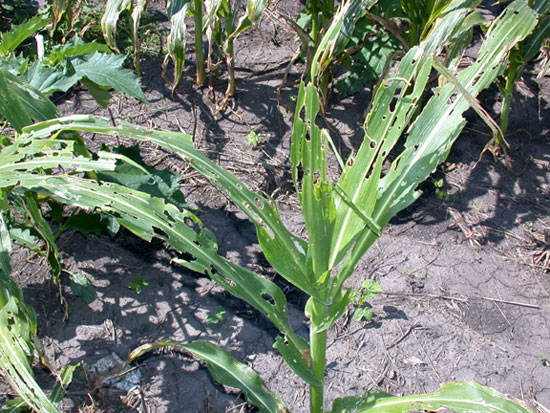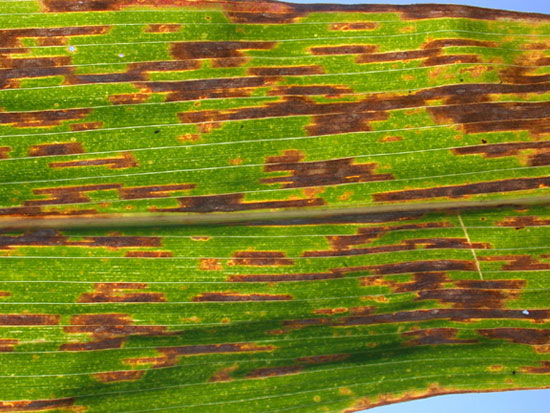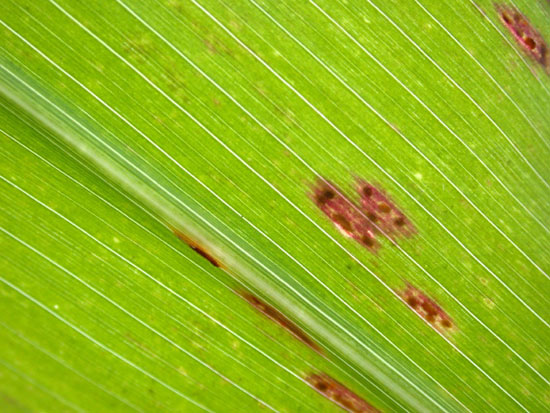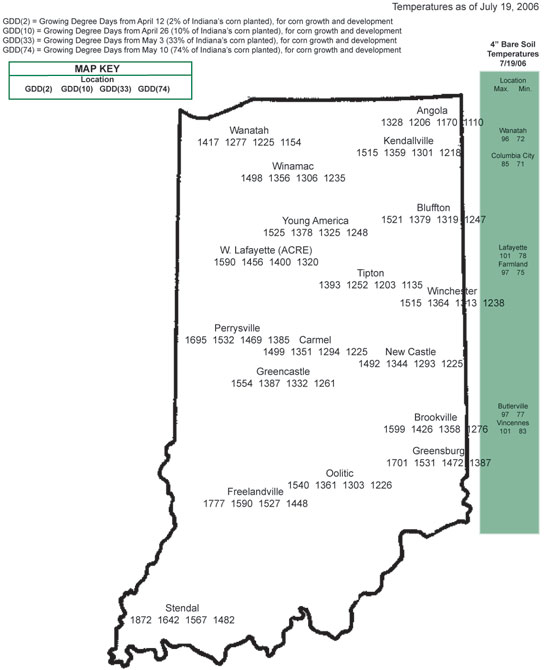Pest & Crop Newsletter, Entomology Extension, Purdue University
Riddled Corn Whorls, Most Likely Fall Armyworm - (John Obermeyer, Christian Krupke, and Larry Bledsoe)
- Fall armyworm cause extensive damage to whorls of corn.
- Description of fall armyworm is given.
- When necessary, spot treat with a high-clearance spray rig using ample water.
- Control decisions discussed below.

Whorl stage corn riddled by fall armyworm.
The variability in corn maturities and heights this season “sets the stage” for fall armyworm infestations. Andy Nicholson, Nicholson Consulting, in west central Indiana reported larvae feeding in late whorl corn last week. Consider this a head’s up to pest managers that will be visiting pre-tasseled corn for the remainder of the summer.
Late-planted corn is attractive to fall armyworm moths that migrate into the state from the south. Female moths from southern states will seek whorl stage corn in which to lay their eggs. Initially, small larvae feed on the leaf surface, causing a “windowpane” effect, where the green tissue is removed and a transparent membrane remains. Whorl feeding by larger larvae appears as ragged-edged holes with excessive frass (caterpillar feces) being quite evident. Feeding on cornhusks and kernels may also occur later in the season. If whorl damage is noted, sample by examining 20 consecutive plants in at least 5 areas of the field. Count and record the number of plants showing damage in each area. Determine the percentage of fall armyworm-damaged plants for the field. Also, be sure to note whether the fall armyworm larvae are still present and feeding. It may be necessary to pull some whorls and unroll the leaves to find the larvae. Estimate the size (length) of several of the worms
The head of the fall armyworm is gray, yellow, or brown, with a predominant white, inverted Y-shaped suture on the front. This “Y” distinguishes the fall armyworm from the similar-appearing true armyworm, whose head is pale gray or greenish-brown in color and covered with a network of dark lines. Once worms are over 1-1/2 inch in length they are soon to complete their larval stage and feeding is nearing completion. Also, one should look for parasitized larvae having elongated white balls (eggs of a parasitic fly) usually near the back of the worm’s head. Parasitized larva will reduce feeding and eventually be killed.

Fall Armyworm- note inverted Y-shaped suture on front of head.
In damaged cornfields where the yield is expected to be at least 60% of the normal yield, an insecticide may be necessary if 75% of the plants exhibit feeding damage and the larvae are less than 1-1/4 inch in length. If applying an insecticide, be sure to apply the insecticide using sufficient water to reach the target area. Fall armyworm will often form a “plug” with their frass in the whorl, making it difficult for insecticide penetration. Ground sprays directed over the row are generally more effective than broadcast sprays. Aerial applications are not recommended. Treatments to control fall armyworm in ear tips are not effective. Because fall armyworm damage is often spotty in fields, consider spot-treating these areas with high-clearance ground driven applicators. For insecticides see Extension Publication E-219-W, Corn Insect Control Recommendations – 2006, which can be viewed electronically at http://extension.entm.purdue.edu/publications/E-219.pdf.
![]()
Scouting for Western Bean Cutworm – (Christian Krupke and John Obermeyer)
Since we have found western bean cutworm in the state we have been fielding questions about when and how to scout for this pest. We are still in the midst of our first season with the pest (and have not actually seen damage in the state, only moths in traps so far), so will refer you to some guidelines from Iowa State, who have been dealing with the insect for a few years. Please see the following website for more information: http://www.ent.iastate.edu/trap/westernbeancutworm/node/667.
Please take some photos and/or give us a call if you have a suspected infestation, we would like to have some “Indiana-specific” photo evidence to share. FYI, the majority of moths are being captured near the Northwestern corner of the state (Newton county), which is about what we expected given data from Illinois trapping in adjacent counties in 2005. We have no idea whether we will have any damaging populations as a result, but we now know that the moth is expanding its range east.
![]()
Click for Table.
Black Light Catch Report.
![]()
Fungicides on Field Corn - (Gregory Shaner)
- To spray or not to spray?

Gray leaf spot

Common leaf rust
Several new fungicides have been registered for use on corn in recent years. Many growers are now asking if it is economical to spray fields with these products. Will the increase in yield pay for the treatment? In the past, the low per-acre value of corn generally precluded the use of a foliar fungicide for disease control. A single fungicide application would not provide sufficient control. Rather than needing to rely on fungicides for disease control, corn growers have had available hybrids with genetic resistance to various diseases. For many years, hybrids with resistance to northern corn leaf blight and other leaf blights, as well as to rust, have been available. This remains true today. Gray leaf spot was an exception. This previously minor disease became a major problem in the mid 1990s, and many hybrids proved to be very susceptible. Since then, seed companies have eliminated the extremely susceptible hybrids, and have developed hybrids that show a degree of resistance.
The degree of resistance in a hybrid is only one factor that determines how severe a disease will be. Weather and the local abundance of the pathogen are also important. Recent weather seems favorable for leaf diseases of corn. Warm nights, high humidity, and frequent rains are favorable for spore production and infection. Except for rust fungi, whose spores are carried here by winds from overwintering sites well south of Indiana, the pathogens that infect corn leaves survive in residue from the previous year’s crop. The widespread practice of reduced tillage or no tillage when soybean is planted after corn means that there is no shortage of corn residue, and hence inoculum, in Indiana. Spores produced on residue can move readily from field to field, so corn planted after soybean on clean ground is still at risk. However, corn planted after corn under reduced tillage is subjected to a greater abundance of inoculum, and disease may appear earlier in such fields than in fields without corn residue.
Not all corn hybrids have a sufficient degree of resistance to all the major leaf blights. Single applications of newer fungicides have performed well in some circumstances. To decide whether to use a fungicide in a field, a grower should determine if the hybrid is susceptible to one or more leaf diseases. If it is, and particularly if there is residue from last year’s crop within or near the field, a fungicide may be economically justified.
Although leaves of most corn still look healthy, I am starting to see lesions of gray leaf spot in some fields. I have seen some northern corn leaf blight. Rust pustules are evident on upper leaves in some fields. Given recent weather, it is likely that more disease symptoms will show up over the next couple of weeks.
There are no reliable thresholds for determining when and if a fungicide is indicated. In itself, the presence of a few lesions or pustules on the ear leaf or above around the time of tasseling does not necessarily mean that a field will sustain loss from disease. On hybrids with partial resistance, it is possible to find a few lesions at mid canopy, but the disease may not become much more severe as the season progresses. Conversely, if the hybrid has weak resistance to a disease, presence of lesions at mid canopy around the time of silking may indeed mean that disease will become severe before the corn reaches physiologic maturity.
In summary, base the decision to use a fungicide first on the hybrid’s resistance or lack thereof to important diseases in this region—gray leaf spot, northern corn leaf blight, and common rust. Consider also cropping history and tillage, because they affect pathogen abundance. Potential yield is important. A field with high yield potential is more likely to respond profitably from a fungicide application than a field with low yield potential. Another consideration this year is the stage of crop development. There was a lot of replanting owing to poor stand establishment during May. A hybrid that was planted late and that is now lagging behind in development may be at greater risk from disease than it would be if it had been planted in a timely manner. However, consider the yield potential in these late-planted fields.![]()
Warm Enough for You? - (Bob Nielsen)
With the air conditioner on the fritz down at the Chat ‘n Chew Café, the few faithful patrons sweltering in the heat and humidity of the lunch time ambiance have been questioning whether the corn crop is suffering as much as they are. The simple answer is “…probably not.”
Yield loss related to excessive heat in the Eastern Corn Belt usually goes hand in hand with dry soil conditions. The nearly statewide rains of last week have enabled many Indiana cornfields to weather (no pun intended) the current hot spell with minimal, if any, effects on yield potential. With ample soil moisture, temperatures in the low 90’s are not terribly stressful on corn, even if it is in the middle of pollen shed and silking. Exceptions to this obviously include fields with severe soil compaction, rootworm larval feeding injury, or otherwise shallow root systems.
Throughout this past hot weekend, pollen was plentiful during the relatively cooler morning and evening hours in my field plots at the Purdue Agronomy Farm (yes, I know that’s good “dirt” there). Fresh silks continued to lengthen their normal 1 to 2 inches per 24 hours. Exposed silks appeared to be moist and receptive.
Once the bulk of the crop finishes the pollination period, then attention will turn toward the early stages of grain fill. Yield loss during grain fill can occur from abortion of young developing kernels (blister to early milk stage of kernel development) or from lighter weight surviving kernels (Nielsen, 2005).
IF, and I emphasize IF, soil moisture conditions would deteriorate significantly over the next few weeks to a month AND the heat spell were to continue, THEN one could begin to talk about possible yield losses due to heat and drought. At the moment, the forecasts don’t seem to be pointing towards that scenario. Temperatures are to moderate later this week and through the weekend. The current NWS 8 to 14 day forecast (as of 17 July) calls for normal temperatures and normal to above normal rainfall throughout Indiana for the remainder of the month.
Statewide USDA estimates indicate nearly half of the state’s corn crop is now in the critical pollination period (USDA-NASS Weekly Crop & Weather Report, 17 July). By now, that number is obviously higher and by next week at this time could be as much as 75% of the state’s crop. That will leave the remaining 25% of the crop planted or replanted in late May or early June to pollinate in the early days of August.
Related References
Nielsen, R.L. (Bob). 2005. Kernel Set Scuttlebutt. Corny News Network. Purdue Univ. Online at http://www.kingcorn.org/news/articles.05/KernelSet-0809.html [URL verified 7/17/06].
USDA-NASS. 17 July 2006. Indiana Weekly Crop & Weather Report. Online at http://www.nass.usda.gov/Statistics_by_State/Indiana/Publications/Crop_Progress_&_Condition/
2006/we2906.pdf [URL verified 7/17/06].
For other Corny News Network articles, browse through the CNN Archives at http://www.kingcorn.org/news/archive.html.
For other information about corn, take a look at the Corn Growers’ Guidebook at http://www.kingcorn.org.![]()


